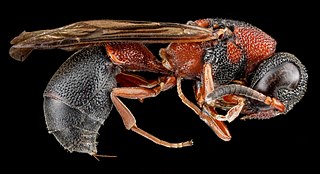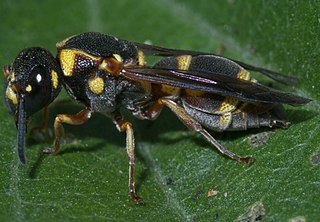
Leptochilus is a large, mostly Holarctic genus of small sized potter wasps. The genus reaches its largest diversity in the Palearctic where there are more than 135 species belonging to 5 subgenera. However the division of The division of Leptochilus into subgenera can not be fully supported and the status of some of them is dubious.

Synagris is an Afrotropical genus of large potter wasps. Several Synagris wasps are strongly sexually dimorphic and males bear notable morphological secondary sexual traits including metasomal lamellar or angular protruding structures and hornlike or tusklike mandibular and/or clypeal projections.

Katamenes is a genus of potter wasps with species distributed in Europe and Africa. When originally named by Edmund Meade-Waldo, Katemenes was monotypic, containing only K. watsoni, but other species have since been moved from Eumenes to Katamenes.

Stenodynerus is a rather large genus of potter wasps whose distribution spans the Nearctic, Palearctic, Oriental and Neotropical regions. Most of its species lack a transverse carina on the first metasomal tergum. A pair of medial pits on the anterior face of the pronotum and the expansion of the tegulae put this genus close to genera as Parancistrocerus, Hypancistrocerus and Eustenancistrocerus.
Knemodynerus is a genus of potter wasps distributed through the Palearctic, Afrotropical, Indomalayan and Australasian regions. The species currently classified in the genus are:
Stroudia is an Afrotropical genus of potter wasps.
Leptomenes is a mainly Afrotropical genus of potter wasps. It was previously a much larger genus, though many species have been transferred to other genera such as Eumenidiopsis, Stroudia, and Tachymenes.
Eustenancistrocerus is an Afrotropical, Palearctic and Oriental genus of potter wasps. The species in this genus include:
Ischnogasteroides is an Afrotropical and Palearctic genus of potter wasps. It currently includes the following species:
Micreumenes is an Afrotropical genus of potter wasps with 30 described species.
Ovodynerus is an Afrotropical genus of potter wasps which contains eleven species.
Paravespa is an Afrotropical and Palearctic genus of potter wasps.

Microdynerus is a genus of potter wasps in the family Vespidae.
Pseudepipona is a genus of potter wasps found in the Palearctic, Nearctic, Afrotropical and Australian regions.

Pterocheilus is an essentially holarctic genus of potter wasps with a fairly rich diversity in North America and a single Afrotropical species Pterocheilus eurystomus Kohl 1906 known from Socotra. They are usually rather large wasps characterized by reduced tegulae and prominently pilose labial palpi.
Rhynchalastor is a moderately large afrotropical genus of potter wasps with 25 species currently known. Some authorities expand the genus to include species otherwise classified under related genera such as Stenodynerus
Hemipterochilus is a Palearctic genus of potter wasps. It contains the following species:
Labochilus is a Palearctic genus of potter wasps. It contains the following species:
Labus is an Indomalayan genus of potter wasps. It contains the following species:
Onychopterocheilus is a Palearctic genus of potter wasps.





